Gaming monitors are becoming increasingly popular as gamers look for a way to upgrade their setup. There are several factors to consider when determining whether a monitor is the best choice for your needs. In this article, we’ll discuss the differences between gaming monitors and TVs and explore which is likely to be the best option.
The first and most obvious difference between a gaming monitor and a TV is size. Monitors can range from 24” to 32” and beyond, while the typical TV size starts at 40”. Generally speaking, larger displays provide a more immersive experience. So, for gaming or watching movies, a larger display may be preferable.
A gaming monitor is also typically designed with gaming in mind. This means they usually come with high refresh rates and quick response times, making them better suited to gaming than regular TVs. Additionally, they often come with advanced features specifically designed to enhance accuracy and reaction times while gaming.
Another key difference is cost. Gaming monitors tend to be more expensive than TVs, primarily due to the premium features they offer. TVs usually have more features, but they are usually not designed with gaming in mind. Monitors on the other hand are designed with gamers in mind, so they come with all the features needed to provide a great gaming experience.
In terms of visuals, there is not a huge difference between monitors and TVs. Generally speaking, modern TVs offer better image quality than most monitors. However, for gamers, the response time and refresh rate of the monitor can have a greater impact on the overall gaming experience.
Ultimately, the decision of which is the best for gaming is up to personal preference. For some, budget may be the deciding factor, while others may prioritize features and visuals. However, if the goal is to gain an edge in competitive gaming, then a monitor is likely to be the best option.
What Makes A Gaming Monitor Great?
A good gaming monitor should be designed to enhance the gaming experience, with features such as a high refresh rate and low response time. Some of the more advanced models come with features such as variable refresh rates (VRR) or adaptive sync. These features help reduce input lag and eliminate screen tearing, allowing for smoother gameplay.
The size of the monitor also plays a role in how great a gaming experience one can have. A larger monitor will provide a more immersive experience and make it easier to distinguish different objects. Monitors are usually offered in sizes ranging from 24” to 32”, whereas TVs usually start at 32”.
Another factor to consider is the connectivity options. Most monitors offer a variety of ports, so you can easily connect your gaming console or other devices. This is important if you want to use multiple gaming devices at the same time.
Furthermore, it is important to look at the panel type. The two main types are TN and IPS panels. TN panels generally offer faster response times, while IPS panels offer better image quality. Depending on your gaming needs, one type may be better than the other.
Finally, you should also look at the features offered with the monitor. Most gaming monitors come with features such as eye-tracking technology, FreeSync, and G-Sync. These features can help improve accuracy and reduce input lag, so it is important to consider your needs and make sure that the monitor you choose includes the features you need.
Advantages of TV For Gaming
One of the biggest advantages of a TV for gaming is cost. TVs are generally cheaper and more accessible than monitors. Plus, they come with a range of features, such as better audio and better picture quality, which can enhance the gaming experience. Moreover, some TVs come with integrated gaming features, such as motion control, which can make some types of gaming more enjoyable.
Another advantage of TVs is size. TVs usually start at 40”, which is considerably larger than most monitors. Furthermore, TVs often come with more ports and connections, so they can be connected to various gaming devices. This makes them better suited for multiplayer gaming.
Finally, some TVs come with features that can further enhance your gaming experience. Most modern TVs come with HDR, which can provide better contrast and richer colours. Additionally, some TVs offer adaptive sync, which can eliminate screen tearing and reduce input lag. These features can dramatically improve the gaming experience.
The Best Option For You
It really depends on what you prioritize in your gaming experience. A gaming monitor may be the best option if you need a smooth, fast, and accurate gaming experience. On the other hand, if you prioritize cost and size, a TV is likely to be the better choice. Ultimately, the best option for you depends on your individual needs and budget.
Things To Consider Before Buying
Before buying a gaming monitor or TV, it is important to consider your needs and budget. You should also think about the size, resolution, and display type that you need for your gaming setup. Furthermore, it is important to look for features such as G-Sync and FreeSync, which can help reduce input lag and improve accuracy. Finally, don’t forget to consider the cost of the monitor or TV and the additional accessories you may need.
Factors That Affect Performance
The performance of a gaming monitor or TV is primarily determined by the resolution, refresh rate, and response time. The higher the resolution, the better the image quality, while a higher refresh rate and response time will provide smoother and more responsive gameplay. Additionally, the panel type (TN or IPS) can also affect performance, as TN panels usually offer faster response times, while IPS panels usually offer better image quality.
Quality Of Graphics
The quality of the graphics on a gaming monitor or TV is determined by the resolution and panel type. Generally speaking, the higher the resolution, the better the image quality. Additionally, IPS panels tend to offer better image quality than TN panels. Furthermore, some modern TVs come with HDR and local dimming features, which can further enhance the image quality.


